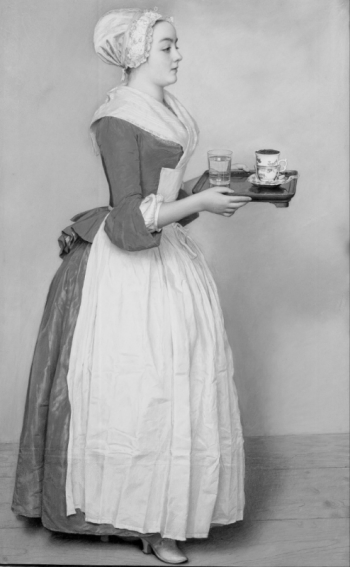Chocolate for the Soldiers
Chocolate was such a highly cherished treat in the 18th century that it was included in the rations of British soldiers fighting in the American Colonies during the French and Indian Wars. Hot chocolate had been introduced in Europe to the 16th C. Spanish by the native peoples of Mexico. It was prepared with chili powder, vanilla, and honey. After its original debut, the fad was to add a little spice and a little of this or a little of that. Often the vanilla stayed, a sweetener always did, but the chili was quickly scratched off the ingredient list.
The chocolate drink was a well-established offering in the coffee and tea houses of England by the middle of the 17th century, and it would soon be enjoyed in the American Colonies. By the early 18th century, cocoa beans were being ground in Boston. The public was alerted to this new and improved process in an advertisement in the Boston Gazette, Sept 5/12, 1737 –“By a gentleman of this Town, Salem, is this Day bro’t to perfection, an Engine to Grind Cocoa; …and it may be depended on for Truth, that it will in less than six Hours bring one Hundred weight of Nuts to a consistence fit for the Mold. And the Chocolate made by it, is finer and better, the Oyly Spirit of the Nut being almost altogether preserved, ….”
Chocolate presented itself as a practical commodity because it could be ground and formed into cakes that lasted a very long time without molding or going rancid. In the 1750s, Benjamin Franklin sought out enough chocolate to provide officers under General Braddock with a ration for their soldiers. This chocolate ration was made into a drink, for chocolate candy, as in chocolate bars or other confections, had not yet been developed. Introduction of the chocolate bar was still a good 100 years off.
In 1857 a Swiss by the name of Daniel Peter began experiments to produce a good milk chocolate, but it wasn’t until 1875 that he perfected his chocolate bar. During this period he partnered with Henri Nestle, and in 1879 they formed the Nestle Company. During this same time, Rodolphe Lindt, also from Switzerland, perfected the machine that would grind and process the chocolate into a powder that was suitable for candy production. Nestle and Lindt, now well-known chocolatiers, were joined by Cadbury in 1868. Whitman started carrying chocolates in 1877 and Hersey in 1894.
Chocolate showed up again as a military ration in 1937, this time in the form of a chocolate bar. Called Ration D, it became a standard issue for the United States servicemen. Then the demand by the military for a chocolate bar that would hold up under extreme conditions such as high temperatures, led to the creation of a variation of ration D and Ration K that were not well received by those who found the bars among their food kits — a luscious treat they were not.
This brief look at chocolate history was prepared by Louise T. Miller, education director at the Lincoln County Historical Association. The Lincoln County Historical Association is a nonprofit organization that also provides stewardship for the 1754 Chapman-Hall House in Damariscotta, 1811 Old Jail and Museum in Wiscasset, and the Pownalborough Court House in Dresden. For more information about the Lincoln County Historical Association, visit lincolncountyhistory.org and the Facebook page, Lincoln County Historical Association Maine.





























